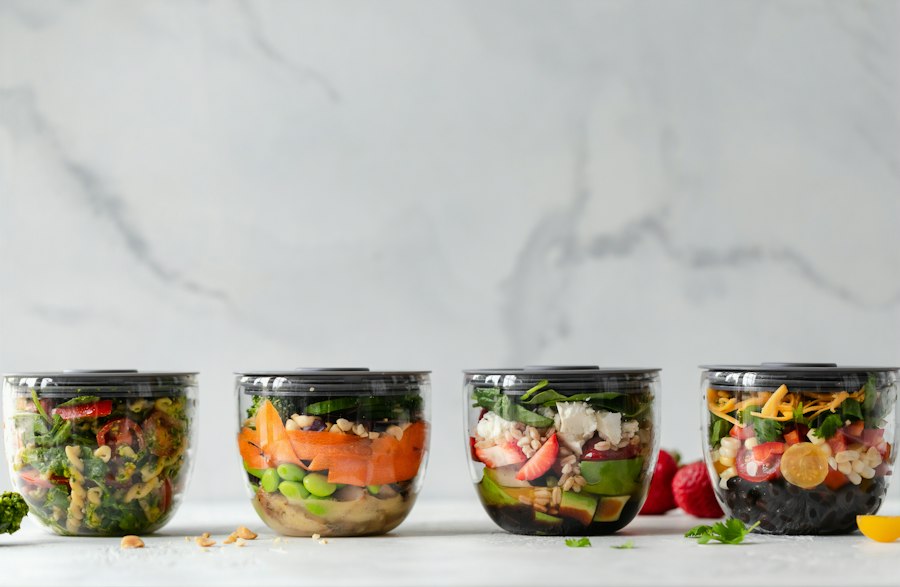Container Gardening: How to Grow Asparagus in a Small Space

Container gardening is a method of growing plants in containers rather than in the ground. It is a popular option for those who have limited space, such as apartment dwellers or those with small yards. Container gardening offers many advantages, including the ability to grow a wide variety of plants, flexibility in location, and ease of mobility.
One of the main advantages of container gardening is the ability to grow plants in small spaces. With container gardening, you can utilize balconies, patios, or even windowsills to create a beautiful and productive garden. This is especially beneficial for those who live in urban areas where outdoor space is limited. Container gardening also allows you to control the soil quality and composition, which can be particularly useful if you have poor soil in your area.
Key Takeaways
- Container gardening is a great way to grow plants in small spaces or areas with poor soil.
- Growing asparagus in containers has many benefits, including easier maintenance and protection from pests.
- When choosing a container for asparagus, make sure it is deep enough and has good drainage.
- Asparagus requires well-draining soil and regular fertilization to thrive in containers.
- Plant asparagus crowns in containers in early spring and keep the soil moist but not waterlogged.
Benefits of Growing Asparagus in Containers
Asparagus is a nutritious and delicious vegetable that can be easily grown in containers. It is packed with vitamins and minerals, including vitamins A, C, E, and K, as well as folate and potassium. Asparagus is also low in calories and high in fiber, making it a healthy addition to any diet.
Growing asparagus in containers offers several space-saving advantages. Asparagus plants have deep root systems that require a lot of space to grow properly. By growing them in containers, you can provide them with the necessary depth without taking up a large amount of ground space. This is especially beneficial for those with small yards or limited garden space.
Another advantage of growing asparagus in containers is the flexibility in location and mobility. Asparagus plants prefer full sun but can tolerate some shade. By growing them in containers, you can easily move them around to find the best spot for optimal sunlight exposure. This is particularly useful if you have limited sunny areas in your yard or if you want to bring your asparagus plants indoors during colder months.
Choosing the Right Container for Asparagus
When choosing a container for growing asparagus, there are several factors to consider. The size and depth of the container, the material it is made of, and the drainage capabilities are all important considerations.
Asparagus plants have deep root systems, so it is important to choose a container that is at least 18 inches deep. This will allow the roots to grow properly and prevent them from becoming root-bound. The width of the container should be at least 12 inches to provide enough space for multiple asparagus crowns.
When it comes to materials, there are several options available. Plastic containers are lightweight and easy to move around, but they may not be as aesthetically pleasing as other options. Clay or ceramic containers are more attractive but can be heavy and may require additional drainage holes. Fabric containers are another option, as they are lightweight and allow for good airflow to the roots.
Drainage is crucial for container gardening, as excess water can lead to root rot and other issues. Make sure your chosen container has drainage holes in the bottom to allow excess water to escape. You can also place a layer of gravel or broken pottery in the bottom of the container to improve drainage.
Soil and Fertilizer Requirements for Asparagus
| Soil and Fertilizer Requirements for Asparagus | |
|---|---|
| Soil pH | 6.5-7.5 |
| Soil Type | Well-drained, sandy loam |
| Nutrient Requirements | High in potassium, moderate in nitrogen and phosphorus |
| Fertilizer Application | Apply 1-2 pounds of 10-10-10 fertilizer per 100 square feet in early spring before growth begins |
| Organic Matter | Apply 2-4 inches of compost or well-rotted manure in fall or early spring |
Asparagus plants prefer well-draining soil with a pH level between 6.0 and 7.0. They also require a nutrient-rich soil to thrive.
To create the ideal soil for asparagus, mix equal parts of compost, peat moss, and perlite or vermiculite. This will provide good drainage while retaining moisture and nutrients. You can also add organic matter, such as well-rotted manure or compost, to improve the soil’s fertility.
Asparagus plants have specific nutrient requirements that need to be met for optimal growth. They require high levels of phosphorus and potassium, so it is important to choose a fertilizer that is high in these nutrients. Look for a balanced fertilizer with an NPK ratio of 10-20-20 or similar. Apply the fertilizer according to the package instructions, usually in early spring before the spears emerge.
Planting Asparagus in Containers
Before planting asparagus in containers, it is important to prepare the container and soil properly. Start by cleaning the container and ensuring it has proper drainage holes. If using a clay or ceramic container, soak it in water for a few hours to prevent it from absorbing too much moisture from the soil.
Next, fill the container with the prepared soil mixture, leaving about 2 inches of space at the top. Gently firm down the soil to remove any air pockets.
Choose healthy asparagus crowns from a reputable nursery or garden center. Look for crowns that are firm and have healthy, white roots. Soak the crowns in water for about an hour before planting to rehydrate them.
Plant the asparagus crowns about 6 inches apart in the container, with the buds facing up. Cover them with about 2 inches of soil, making sure not to bury them too deep. Water thoroughly after planting to settle the soil and provide moisture to the roots.
Watering and Maintenance of Asparagus Plants

Proper watering is essential for the health and growth of asparagus plants. They require consistent moisture but should not be overwatered, as this can lead to root rot and other issues.
Water your asparagus plants deeply once or twice a week, depending on weather conditions. The soil should be moist but not waterlogged. To check if your plants need water, stick your finger about an inch into the soil. If it feels dry at that depth, it is time to water.
Mulching can help retain moisture in the soil and prevent weed growth around your asparagus plants. Apply a layer of organic mulch, such as straw or wood chips, around the plants, taking care not to cover the crowns. This will also help regulate soil temperature and prevent fluctuations.
Pruning and thinning are important maintenance tasks for asparagus plants. In the first year, allow the spears to grow without harvesting to allow the plants to establish a strong root system. In subsequent years, harvest the spears when they are about 6-8 inches tall by cutting them at ground level.
After the harvest season, allow the remaining spears to grow into fern-like foliage. This foliage is important for photosynthesis and nutrient storage. In late fall or early winter, cut back the foliage to about 2 inches above the ground and remove any debris from the container.
Pest and Disease Control for Asparagus in Containers
Asparagus plants can be susceptible to certain pests and diseases, but with proper care and prevention, these issues can be minimized.
Common pests that can affect asparagus plants include aphids, slugs, and beetles. To prevent these pests, keep your container garden clean and free of debris. Regularly inspect your plants for signs of infestation and take appropriate action if necessary. You can use organic pest control methods such as insecticidal soap or neem oil to treat infestations.
Asparagus plants can also be susceptible to diseases such as crown rot and rust. To prevent these diseases, make sure your container has proper drainage to avoid waterlogged soil. Avoid overwatering and provide good air circulation around your plants. If you notice any signs of disease, such as yellowing or wilting foliage, take immediate action to prevent further spread.
Harvesting and Storing Asparagus
Harvesting asparagus is a rewarding experience, but it is important to do it at the right time and in the right way to ensure optimal flavor and quality.
The timing of harvest depends on the age of your asparagus plants. In the first year, allow the spears to grow without harvesting to allow the plants to establish a strong root system. In subsequent years, harvest the spears when they are about 6-8 inches tall by cutting them at ground level. Harvesting too early or too late can result in tough and woody spears.
To store harvested asparagus, place them in a plastic bag or container and store them in the refrigerator. They can be kept for up to a week, but it is best to consume them as soon as possible for maximum freshness and flavor.
Companion Planting for Asparagus in Containers
Companion planting is the practice of growing different plants together to benefit each other. When it comes to asparagus, there are several companion plants that can help improve growth and deter pests.
One of the main benefits of companion planting with asparagus is pest control. Planting marigolds or nasturtiums near your asparagus plants can help repel pests such as aphids and beetles. Herbs such as dill and parsley can also attract beneficial insects that prey on pests.
Another benefit of companion planting is improved soil fertility. Planting nitrogen-fixing plants such as legumes or clover near your asparagus plants can help enrich the soil with nitrogen, which is essential for plant growth.
When choosing companion plants for asparagus, it is important to consider their compatibility. Avoid planting vegetables or herbs that have similar nutrient requirements or growth habits, as they may compete for resources. It is also important to consider the size and spread of companion plants to ensure they do not overcrowd or shade your asparagus plants.
Conclusion and Final Thoughts on Container Gardening with Asparagus
Container gardening offers many advantages, including the ability to grow a wide variety of plants in small spaces. Growing asparagus in containers provides numerous benefits, including health benefits, space-saving advantages, and flexibility in location and mobility.
When choosing a container for asparagus, consider the size, depth, material, and drainage capabilities. Provide your asparagus plants with well-draining soil that is rich in nutrients. Plant the asparagus crowns properly, ensuring they have enough space to grow and develop.
Proper watering, mulching, pruning, and thinning are important maintenance tasks for asparagus plants. Take steps to prevent pests and diseases, and harvest your asparagus at the right time for optimal flavor and quality.
Consider companion planting to improve growth and deter pests. Choose compatible plants that will not compete for resources or overcrowd your asparagus plants.
Container gardening with asparagus can be a rewarding and enjoyable experience. With proper care and attention, you can enjoy a bountiful harvest of fresh and delicious asparagus right from your own container garden.



